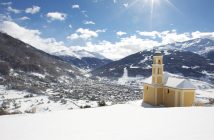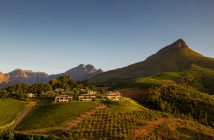Beyond the package holidays and packed beaches, tucked away from the tourist traps and frenetic resort towns, Jess Baldwin finds an Algarve of quiet hillsides and rustic markets, of tranquility and local culture, and from a base all to herself…
We are eagerly squinting in to the darkness at a curious trail of twinkling lights. Are we on the coast? They could be boats. Or maybe we are in the hills? They could be houses. We have just arrived in The Algarve, well, I hope that is where we are. Having arrived in the dead of night quite frankly, we have no idea. We listen for clues; the frenzied tweeting of birds that greeted us as the sun melted away in to the blood red sky has been replaced by the call of busy cicadas and dog barks dissolving in to the darkness. Water swirls and folds somewhere nearby and a lone cockerel crows in want of a reply. Somewhat discombobulated I head to bed feeling like a child on Christmas Eve, eager to open the shutters in the morning and see what awaits. Please God, don’t let it be snow.
Morning has broken and the vivid sky is neon behind the dancing palms. Villa Gomes, I see now, is quietly perched in the hills overlooking miles of terracotta fields carpeted with pine, eucalyptus and olive trees. The peaceful lowlands stretch out towards the Atlantic which listens on the horizon, interrupted only by the odd whitewashed neighbour. It is perfect.
The three bedroom villa is enormous and its grounds are surprisingly grand with manicured lawns fringing our private pool and a tennis court and table tennis table sparking my competitive streak. As the sun rises, a ricochet of cockerel calls echo through the valley against the sound of rustling palms and birds excitably gear up for the day ahead.

Over breakfast on the sun-teased terrace we plan our stay. Until now I had never felt the need to visit The Algarve, presuming it was all busy resorts and crowded beaches, but as I sat and listed ancient ruins, Moorish castles, historic fishing villages and a neighbouring palace I wondered how it had escaped me for so long. With around 200km of coastline boasting some of Europe’s best beaches, the area’s inland attractions are often overlooked. Decision made, we would begin our adventure inland!
Our first stop was the charming town of Estoi, just five minutes’ drive from Villa Gomes. Nestled in the foothills of Serra do Caldeirão, Estoi is famous for its Roman ruins and 19th century Rococo style ‘pink palace’. Its meandering cobbled streets are home to colourful houses proudly displaying ornate Azulejo tiles and fantastically ostentatious chimneys. Forget who has the flashiest BMW, chimneys are the ultimate status symbol here – and yes, it is the size that counts. Nobody seems to agree on the origins of this architectural phenomenon, but many locals claim that the minaret-style chimneys stem from the days of Al Gharb, when the Moors rules the area for 500 years (despite architecture of that time not using chimneys). Either way, Villa Gomes’ barbeque alone has a towering 10ft chimney – just saying.

We timed our trip well, coinciding with Estoi’s famous monthly market. Entering the dusty grounds, I felt as though we were in a Moroccan souk, with bellowing plumes of black smoke wafting across the sea of stalls, heavy in the mouth-watering scent of roasting chicken – forget Nando’s, this place is the real deal. Having grabbed the last table, we tucked in to tender freshly cooked chicken, pork and fries as a burly accordion player rocked up with an unlikely wing man… a tiny Chihuahua, sat upon his accordion, loyally holding the busking bowl in its mouth – well, who needs a Pitbull when you have a huge chimney at home.
Next on our itinerary was Tavira, once the area’s most important port, it used to Portugal’s gateway to northern Africa. Straddling the picturesque Gilão River the town’s two halves are adjoined by a Roman bridge. Today it’s historic streets are lined with pavement cafes, pastelarias and craft shops selling local cork, baskets and pottery. Amazingly Tavira has over 30 churches, many with amazing histories and surprisingly ornate interiors. We visited the Church of Sao Francisco, which despite two earthquakes, a fire and a collapse, remains open to the public today. Inside it displays various statues dating from 15th – 18th centuries as well as ornate ceilings and baroque altar carvings. From here we ambled our way through its narrow alleys and side streets towards the river, where gulls cried overhead as local man quietly sifted for clams in the shallows. From here you can take boats around Ria Formosa Natural Park, famous for its beaches and rare birds – it’s bursting with flamingos and boasts one of the world’s largest sea horse populations… not to mention the infamous Portuguese Water Dog.

It didn’t take long for us to sniff Olhão; Portugal’s largest fishing port and a Mecca for seafood fans. Just 10 minutes from Villa Gomes the picturesque seaside town has an immaculately kept indoor market, half of which is dedicated to the ocean’s bounty. Alongside the usual sardines and salmon lay enormous octopus, sleek rays and elaborate conch. Opposite is an endless line of seafood restaurants – ‘A Polvaria’ caught our eye, more modern than its neighbours and solely to octopus. Well, if you specialise in just one ingredient, you are going to do it well… aren’t you? I have never tasted such tender octopus; the texture was like silken tofu.
Vilamoura is one of the better known coastal spots. With a popular marina, high-end boutiques and championship golf courses it seemed like the obvious choice for a post-sightseeing pamper session. I was bound for the new Anantara Vilamoura Resort, in search of their infamous signature massage. Having opened earlier this year it’s Anantara’s first European venture and they certainly seemed keen to pay homage to the area with local installations, photography and crafts at every turn. The sleek spa on the other hand echoed the brand’s Asian origins. The treatment began with a soothing foot ritual – my tired feet were bathed in warm water and milk before being scrubbed with ground coffee. The masseuse expertly used her hands and elbows to work deep in to my tight muscles, releasing knots and tension and leaving me feeling as though I had melted in to the treatment bed. The spa’s relaxation area, pool and balcony were spectacular, with pristine white loungers staring out past the championship golf course towards the Atlantic.

Before retreating back to the hills, I enjoyed lunch in their casual Portuguese seafood restaurant, Ria. A deliciously light local goat’s cheese served with honey was followed by enormous sautéed shrimps. The Algarvian monkfish rice came with meaty prawns and clams and looked so good that I didn’t declare my suspected mollusc allergy… one clean plate later and I lived to tell the tale – and even if I hadn’t, I think it may have been worth it. As I left the 5* hotel, waving goodbye to its Veuve Cliquot cabanas, I reminded myself that my own hillside palace awaited.
On our last day we returned to beautiful Estoi, bound for the ‘pink palace’. Today an SLH hotel, its dusky pink domes date back to the eighteenth century and perch proudly above its famous gardens (which non-guests can visit). Ornate tiles, elegant statues and elaborate water features are dotted amid its tiered Versailles style gardens. Descending to the lowest tier rewards you with the money shot.

Inside it oozes rococo glamour; think frescoed ceilings, chandeliers and gilt galore. Its minimalist restaurant has an idyllic shade-dappled terrace with endless views towards Faro. A selection of traditional Portuguese starters began proceedings- juicy figs carefully sculpted in to flower heads and filled with a goat’s cheese mouse muddled with fresh chilli was our favourite. The fried baby squid in a red wine jus, infused with garlic and coriander was so good that we ordered bread in order to absorb every drop. My octopus main comprised of meaty tentacles accompanied by candied onions and comforting sweet potato rolled in almond flour. A selection of Portuguese cakes wrapped up our meal nicely and we made our way back to our own palace for the last time.
If only we had longer. We would peruse Loulé’s famous market, visit Silves’ Moorish castle, surrounded by citrus trees and sail around Ria Formosa’s wildlife-ridden islands … Plus, I hear there are some nice beaches in this neck of the woods too.
It’s our last evening in the Algarve. I’m sat on our beloved terrace, with a canopy of stars above me and the moonlight dancing across the ocean beside the warm glow of Olhão. Farol Island’s faithful lighthouse is pulsing away as our palms shimmy in the breeze, teeming with a sunset chorus. As I close my eyes and give in to the meditative sound of cicadas, around the valley cockerels’ distant calls echo around me. The waft of barbeques drifts promiscuously from one hamlet to another, cutting through the nostalgic scent of dry pine, heavy in the air. I can feel the caress of the balmy coastal breeze dusting over my sun-blushed skin like silk. As the night quiets I wonder how, with all of these clues, I could possibly have worried that this place was anything less than perfect.
Villa Gomes can sleep up to 6 adults in three en suite bedrooms and is bookable through villa specialist, Vintage Travel. Prices in 2018 start from £690 for a seven-night holiday. Reservations: 01954 261431. For more information, visit www.vintagetravel.co.uk.




